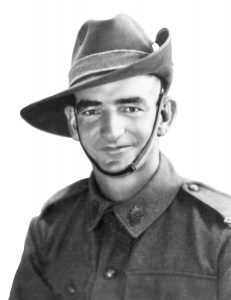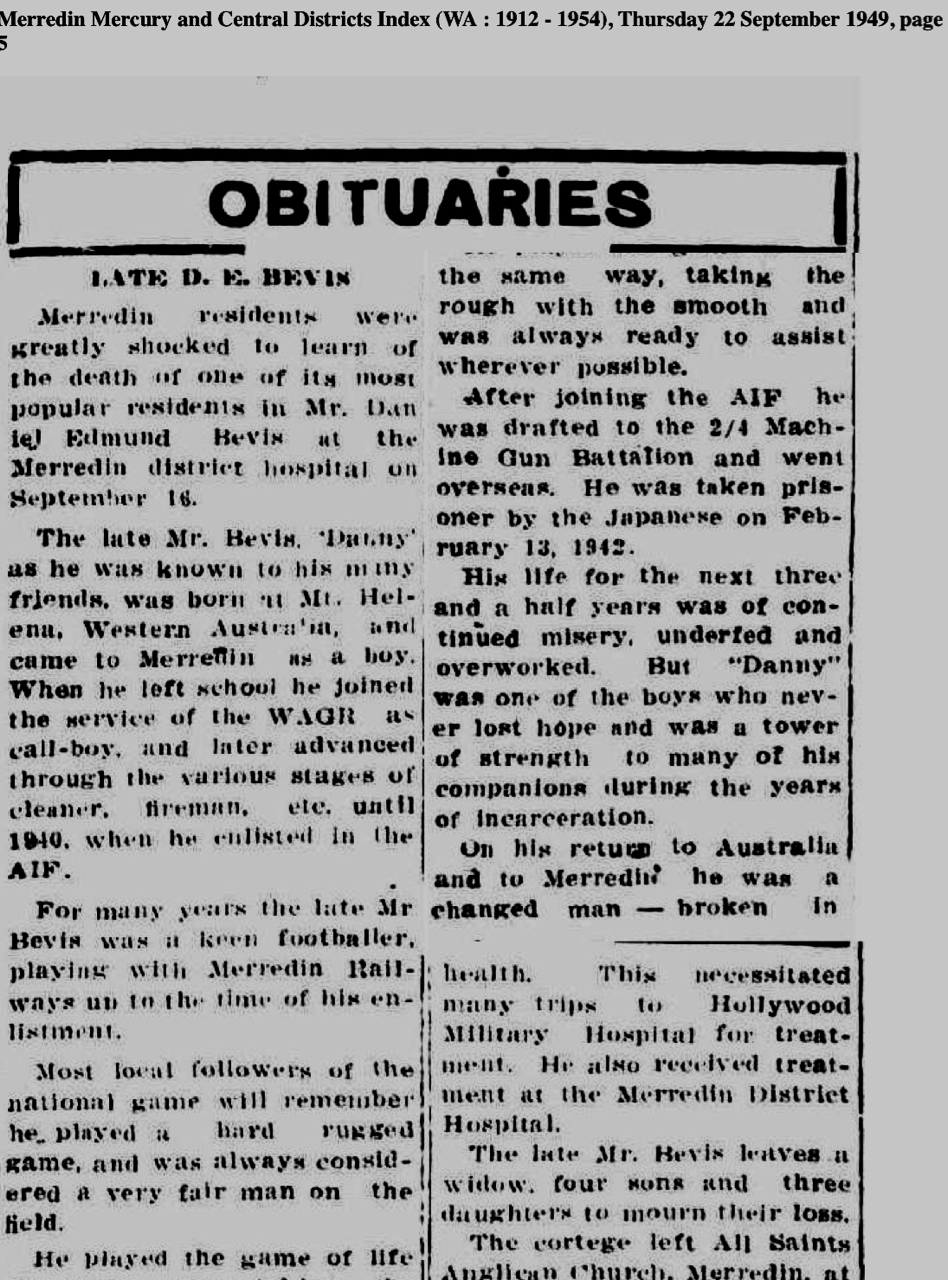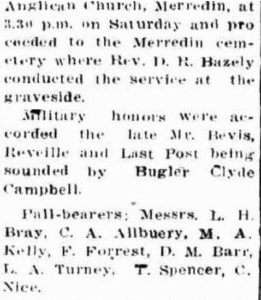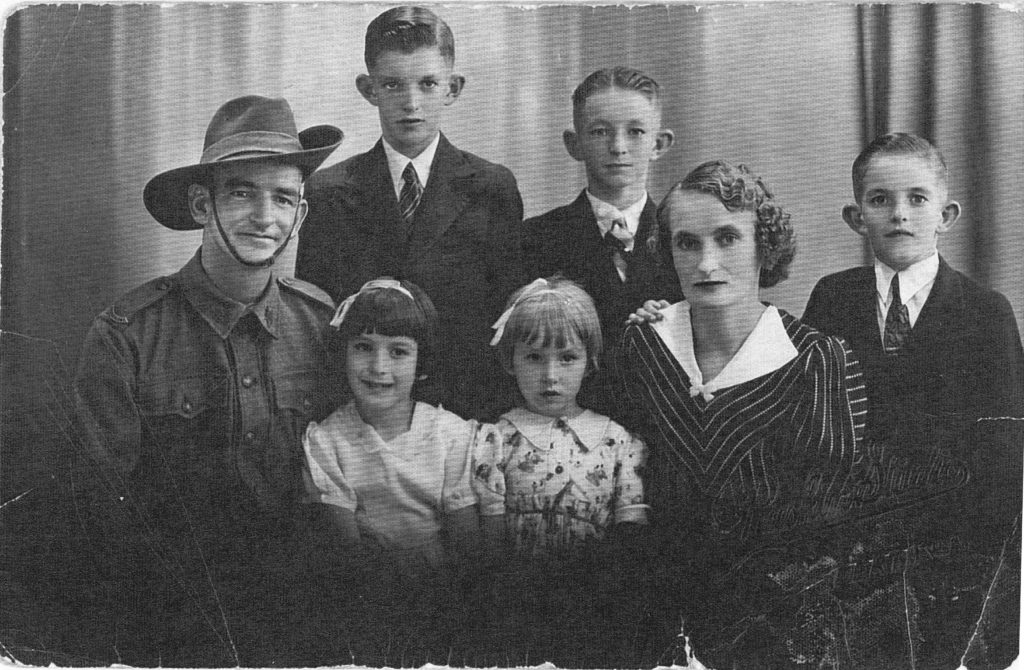NEXTRA MERREDIN ANNUALLY REMEMBERS ANZAC DAY & REMEMBRANCE DAY
Corporal Daniel Bevis WX9061
Shaun Morton is Danny’s Grandson





(place cursor on relevant photograph and hit return for a close up view)

Above: Shaun Morton and his staff at Nextra Merredin.
Every year for one week prior to Anzac Day and Remembrance day, Shaun Morton decorates the Nextra store’s Shop Windows at Merredin in recognition of his Grandfather Danny Bevis of the 2/4th Machine Gun Battalion.
Bevis managed to return to Merredin at war’s end, however like so many former POWs, Danny’s health was fragile. Danny Bevis died 4 years after war’s end in 1949 at Merredin. He was only 40 years old leaving his young wife and a family of seven young children.



Taken prior to departing Australia – Dan and Thelma Bevis with their five children L-R Mervyn, Desmond, Trevor, Beryl and Glenis. Danny and his wife Thelma parented a further two children before his death.
Danny enlisted AIF 25 Oct 1940 and later joined 2/4th MGB’s ‘C’ Coy 11 Platoon under Commanding Officer Lt Boyle.
As a POW he was selected with the first Australian work Party to leave Singapore. ‘A’ Force Burma Green Force No. 3 Battalion would ultimately begin working on the northern, i.e. Burma end of the Burma-Thai Railway. They however would work on three airfields left behind by the British when they departed Burma.
Most of 2/4th POWs first went to Victoria Point where they worked for several months before making their way to the Burma end of the Rail link.
Please read ‘A’ Force Burma Green Force No. 3 Battalion
It was in Burma where Danny dedicated his time as an orderly working extraordinary long hours looking after the ill and dying POWs and assist Australian doctors, including 2/4th’s Claude Anderson and surgeon Albert Coates. Other medical orderlies included Eric Baker and Ritchie.
From Claude Anderson’s interview with Winstanley.
Follow the link below to read Peter Winstanley’s article on Captain Claude L Anderson WX3464 Medical Officer 2/4 Machine Gun Battalion
The following is from Danny’s Diary from the time he arrived in Thailand from Burma, January 1944, this was following Japan’s removal of all POWs working on the Burma end of the Rail link, southwards to one of four or five large camps in Thailand and to hospitals if ill.
Tamarkan, Thailand 2 Jan 1944 –
‘Food good for six weeks to build up the Japan Party, later torpedoed. Camp is 60 yards from bridge of eleven steel spans and a large AA position. Surrounded by observation posts, Nip engineers, cavalry camp and railway line. Twenty one planes over 29 Nov 1944. Four bombs dropped on camp, 18 killed and 38 wounded.
Non Pladuk ,Thailand 30 Nov 1944 – 62 buildings, workshops, etc. wiped out. Bombs and bullets in camp 93 killed and 310 wounded.
Kanchanaburi, Thailand bombed 13 Dec 1944.’
Tamarkan Camp, Thailand
‘Several more raids in December, quiet until 28 Jan 1945. Wooden bridge destroyed and repaired by us. One plane, one bomb, lost one whisky.
5th Feb 1945 – AA half a mile from camp, nip engineers and bridge bombed, 1,000 lb.
23 May 1944 – First Red Cross parcels received. 6 men to one parcel.
28 May 1944 – First mail.’
Chungkai Camp, Thailand
‘Left Tamarkan 12 Feb 1945. March over bridge 6 km to Chungkai. Broke all records going over. Arrived same day.
13 Feb 1945 – bridge blown to pieces.
19 Feb 1945 – left Chungkai.’
Non Pladuk Camp, Thailand
‘Arrived 20 Feb 1945. Spent night of expectancy as previous raid very noticeable. Nothing standing except portion of POW Camp. In train four hours before leaving for Kachu Mountain on 21 Feb 1945. Detrained as blown bridge at Ratburi. Thai’s hostile to Nips. Pontoons over river.’
Kachu Mountain, Thailand
‘March to Kachu Mountain 86 km (53 miles). Self picked up in truck 15 miles out (sick with malaria) and arrive Kachu Mountain 22 Feb 1945. The rest (POWs) arrive in a bad way on 24 Feb 1945. Building two aerodromes No. One 8 kms from POW Camp. No. two, 3 kms from POW Camp. (Remember POWS had to work to and from work back to their camps – 8 and 3 kms is a long way when you are sick and exhausted at the end of the day) Conditions and Nips no Good. Self malaria all the time, nearly passed out.
28 April 1945 – 26 planes go over strafing the aerodrome. Machine Gun mounted by Nips outside hospital hut. Plenty Blackwater fever. Storms every night. 7 huts blown down in typhoon. I eat python and armadillo, not too bad.’
July 1945 – 1,000 POWs were transferred from Kachu Mountain Camp to Petchaburi, Thailand.’
Petchaburi, Thailand
‘Left Kachu Mountain 1 July 1945 marched to Petchaburi (18 miles). Self in truck after 10 miles, malaria again.’
Ratburi, Thailand
‘Train to Ratburi, damage of previous planes evident. Stopped for night sitting up. Chinese say war one more month, he was right.’
Nacompaton, Thailand
‘Through Nacompaton, largest pagoda ever seen. There are hundreds of legless and armless POWs here, bridge blown to pieces.’
Nacompaton had been set up from Dec 1943 as a large hospital and convalescing camp. There were several members from 2/4th involved with the construction of this camp, including Eric Fraser and Frank ‘Blue’ Evans. This is where men like Tom Barbour, Syd Gorringe, Eric Ryan and Allan Bamford to name a few who had limbs amputated, and would remain here until the end of the war. The camp itself was located about 30 miles to the west of Bangkok. As well as amputees (amps) there were many POWs sent to this camp to build sup their strength following the construction of the rail link. As their health improved slightly they were again called upon to depart Nacompaton on work parties. On Japan’s surrender in August 1945 Nacompaton became an Allied Forces collection centre for ex POWs who were then either moved out via Bangkok to Singapore direct or via Rangoon to Singapore.
Bangkok, Thailand
‘Arrive Bangkok 3 July 1945. Bombs have wreaked havoc at station and railway workshops. Took barge to go-downs. Big raids two weeks previous. Lofty Holdman, (from 2/4th) killed, roofs wrecked. Do not like it here very much. Left go-downs 6 July 1945. Arrive Pranchanburi 6 July 1945. Left 0100 hours 7 July 1945 for Nakom Nayok.’
Nakom Nayok, Thailand
‘March was murderous and at end of 45 kms men were all in. Nips would not pick up sick. Had been going with no food or boots for 33 hours continuous. Tried to refuse to march when 3/4 of distance was covered on account no water, but rifle and bayonet won the argument, so we staggered on. Arrived Nakom Nayok on 7 July 1945. Long hours and hard work digging dugouts, ammo dumps, etc. in hills 8 km away. Plenty of lightning and storary objectives and confined to an area 75 yards square, under tents. 200 in party and instructed that if any air activity not to move out of area or would be shot. One B29 over and all keyed up for eventualities as one nip plane came from hanger to have a go at him. Nothing happened, nip plane crashed. Self route planned for escape if needed.’
Nakom Nayok, Thailand
‘Told on evening of 16 Aug 1945 that we were to move back to Nakom Nayok next morning 17 Aug 1945. Thai’s shower truck with food etc. and we had an idea something had happened.’
‘On arrival at Nakom Nayok we were elated to see Yank, British and Dutch flags flying and were notified that war had finished. Plane dropped men and supplies on 1 Sep1945, what a sight. One man through roof of hut, also some parcels when chute failed to open. Again on 3rd and 4th September more supplies, clothes and medicine. One plane dare devil flyer, very exciting. Lady Edwina Mountbatten visits camp.’
Bangkok, Thailand
‘Left Nakom Nayok 13 Sept 1945. Arrive Bangkok at Tamasaart University 13 Sept. Wonderful buildings, King’s Palace, pagoda, etc. in Bangkok. On 24 Sept left Bangkok 0850 hours Don Muang Aeorodrome and flew 900-1,000 miles to Singapore, arriving 5 hours 25 minutes flying time at 1415 hours. Bad weather on leaving, crossed Gulf of Siam and South China Sea, thence east coast of Malaya. Views of paddy fields, river and jungles, magnificent. Had a couple of nasty bumps over South China Sea. All Aussie crew onboard a Dakota plane. Height mostly 10,000 feet. Present quarters at Singapore just like civilization again and had my first drink of beer in 3 and 3/4 years. This was a record. Left Singapore on ‘Tamaroa’ 29 Sept 1945.
Home, West Aussie at last, 10 October 1945.’
Also please read about the boys from Merredin
The 2/4th commends Shaun for his dedication and recognition of the soldiers & POWs of WW1 and WW2.
